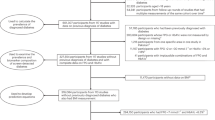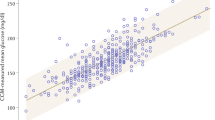Abstract
The purpose of a diagnostic test is to identify individuals who have a disorder and reassure those who do not. An HbA1c-based diagnosis of diabetes mellitus or prediabetes fails to meet that purpose. Diabetes mellitus is a disorder of glucose, not HbA1c, metabolism. Microvascular complications in diabetes mellitus are driven by chronic hyperglycemia. The correlation of these complications with HbA1c levels is convenient; however, unlike the direct information provided by glucose, HbA1c values reflect glycemic and nonglycemic factors. The latter include modulators of glucose transport across the erythrocyte membrane, intracellular protein glycation and deglycation, erythrocyte turnover, systemic illness and hematological and medical disorders, among others. Genetic rather than glycemic factors explain most of the variance in HbA1c levels. Finally, HbA1c values are misleading as a measure of average blood glucose among persons of African, Asian, Hispanic and other non-European ancestry. Given the numerous pitfalls, the use of HbA1c levels for diagnosing diabetes mellitus or prediabetes is ill-advised.
This is a preview of subscription content, access via your institution
Access options
Subscribe to this journal
Receive 12 print issues and online access
$209.00 per year
only $17.42 per issue
Buy this article
- Purchase on Springer Link
- Instant access to full article PDF
Prices may be subject to local taxes which are calculated during checkout
Similar content being viewed by others
References
[No authors listed] The effect of intensive treatment of diabetes on the development and progression of long-term complications in insulin-dependent diabetes mellitus. The Diabetes Control and Complications Trial Research Group. N. Engl. J. Med. 329, 977–986 (1993).
[No authors listed] Intensive blood-glucose control with sulphonylureas or insulin compared with conventional treatment and risk of complications in patients with type 2 diabetes (UKPDS 33). UK Prospective Diabetes Study (UKPDS) Group. Lancet 352, 837–853 (1998).
International Expert Committee. International Expert Committee Report on the role of the A1C assay in the diagnosis of diabetes. Diabetes Care 32, 1327–1334 (2009).
American Diabetes Association. Diagnosis and classification of diabetes mellitus. Diabetes Care 33 (Suppl. 1), S62–S69 (2010).
[No authors listed] Report of the expert committee on the diagnosis and classification of diabetes mellitus. Diabetes Care 20, 1183–1197 (1997).
Genuth, S. et al. Follow-up report on the diagnosis of diabetes mellitus. Diabetes Care 26, 3160–3167 (2003).
van't Riet, E. et al. Relationship between A1C and glucose levels in the general Dutch population: the new Hoorn study. Diabetes Care 33, 61–66 (2010).
Diabetes Research in Children Network (DirecNet) Study Group. Relationship of A1C to glucose concentrations in children with type 1 diabetes: assessments by high-frequency glucose determinations by sensors. Diabetes Care 31, 381–385 (2008).
Hempe, J. M., Gomez, R., McCarter, R. J. Jr & Chalew, S. A. High and low hemoglobin glycation phenotypes in type 1 diabetes: a challenge for interpretation of glycemic control. J. Diabetes Complications 16, 313–320 (2002).
Gould, B. J., Davie, S. J. & Yudkin, J. S. Investigation of the mechanism underlying the variability of glycated haemoglobin in non-diabetic subjects not related to glycaemia. Clin. Chim. Acta 260, 49–64 (1997).
Hudson, P. R., Child, D. F., Jones, H. & Williams, C. P. Differences in rates of glycation (glycation index) may significantly affect individual HbA1c results in type 1 diabetes. Ann. Clin. Biochem. 36, 451–459 (1999).
Tattersall, R. B., Pyke, D. A., Ranney, H. M. & Bruckheimer, B. S. Hemoglobin components in diabetes mellitus: studies in identical twins. N. Engl. J. Med. 293, 1171–1173 (1975).
Snieder, H. et al. HbA(1c) levels are genetically determined even in type 1 diabetes: evidence from healthy and diabetic twins. Diabetes 50, 2858–2863 (2001).
Cohen, R. M. et al. Evidence for independent heritability of the glycation gap (glycosylation gap) fraction of HbA1c in non-diabetic twins. Diabetes Care 29, 1739–1743 (2006).
Paterson, A. D. et al. A genome-wide association study identifies a novel major locus for glycemic control in type 1 diabetes, as measured by both A1C and glucose. Diabetes 59, 539–549 (2010).
Khera, P. K. et al. Evidence for interindividual heterogeneity in the glucose gradient across the human red blood cell membrane and its relationship to hemoglobin glycation. Diabetes 57, 2445–2452 (2008).
National Glycohemoglobin Standardization Program (NGSP). Factors that interfere with GHB (HbA1c) Test Results [online], (2009).
Cohen, R. M. et al. Red cell lifespan heterogeneity in hematologically normal people sufficient to alter the apparent HbA1c. Blood 112, 4284–4291 (2008).
Pani, L. N. et al. Effect of aging on A1C levels in individuals without diabetes: evidence from the Framingham Offspring Study and the National Health and Nutrition Examination Survey 2001–2004. Diabetes Care 31, 1991–1996 (2008).
Kramer, C. K., Araneta, M. R. & Barrett-Connor, E. A1C and diabetes diagnosis: The Rancho Bernardo Study. Diabetes Care 33, 101–103 (2010).
Cowie, C. C. et al. Prevalence of diabetes and high risk for diabetes using hemoglobin A1c criteria in the U. S. population in 1988–2006. Diabetes Care 33, 562–568 (2010).
Ziemer, D. C. et al. Glucose-independent, black-white differences in hemoglobin A1c levels. Ann. Intern. Med. 152, 770–777 (2010).
Saaddine, J. B. et al. Distribution of HbA1c levels for children and young adults in the U. S. Third National Health and Nutrition Examination Survey. Diabetes Care 25, 1326–1330 (2002).
Herman, W. H. et al. Differences in A1C by race and ethnicity among patients with impaired glucose tolerance in the Diabetes Prevention Program. Diabetes Care 30, 2453–2457 (2007).
Selvin, E., Zhu, H. & Brancati, F. L. Elevated A1C in adults without a history of diabetes in the U. S. Diabetes Care 32, 828–833 (2009).
Nathan, D. M. et al. Translating the A1C assay into estimated average glucose values. Diabetes Care 31, 1473–1478 (2008).
Bleyer, A. J. et al. Ethnic variation in the correlation between random serum glucose concentration and glycated haemoglobin. Diabet. Med. 26, 128–133 (2009).
Herman, W. H. et al. Racial and ethnic differences in mean plasma glucose, hemoglobin A1c, and 1,5-anhydroglucitol in over 2000 patients with type 2 diabetes. J. Clin. Endocrinol. Metab. 94, 1689–1694 (2009).
Cohen, R. M., Holmes, Y. R., Chenier, T. C. & Joiner, C. H. Discordance between hemoglobin A1c and fructosamine: evidence for a glycosylation gap and its relation to nephropathy in longstanding type 1 diabetes. Diabetes Care 26, 163–167 (2003).
Christensen, D. L. et al. Moving to an HbA1c based diagnosis of diabetes has a different impact on prevalence in different ethnic groups. Diabetes Care 33, 580–582 (2010).
Acknowledgements
S. Dagogo-Jack is supported in part by NIH grants R01 DK067269 and MO1 RR00211.
Author information
Authors and Affiliations
Ethics declarations
Competing interests
The author declares no competing financial interests.
Rights and permissions
About this article
Cite this article
Dagogo-Jack, S. Pitfalls in the use of HbA1c as a diagnostic test: the ethnic conundrum. Nat Rev Endocrinol 6, 589–593 (2010). https://doi.org/10.1038/nrendo.2010.126
Published:
Issue Date:
DOI: https://doi.org/10.1038/nrendo.2010.126
This article is cited by
-
Impact of triglycerides and waist circumference on insulin resistance and β-cell function in non-diabetic first-degree relatives of type 2 diabetes
BMC Endocrine Disorders (2021)
-
The trials and tribulations of determining HbA1c targets for diabetes mellitus
Nature Reviews Endocrinology (2020)
-
Elevated HbA1c is not associated with recurrent venous thromboembolism in the elderly, but with all-cause mortality– the SWEETCO 65+ study
Scientific Reports (2020)
-
A thorough analysis of diabetes research in China from 1995 to 2015: current scenario and future scope
Science China Life Sciences (2019)
-
Haemoglobin glycation index and risk for diabetes-related complications in the Action in Diabetes and Vascular Disease: Preterax and Diamicron Modified Release Controlled Evaluation (ADVANCE) trial
Diabetologia (2018)



